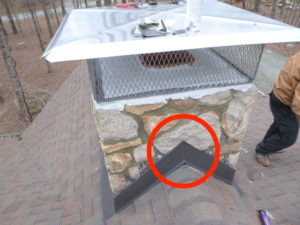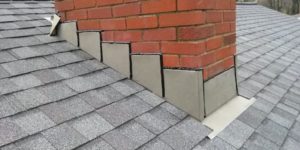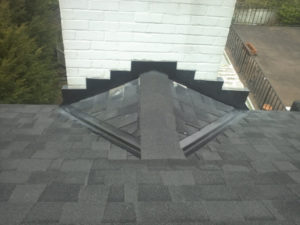Imagine enjoying a quiet night at your home in front of the TV, away from the craziness of life. Will you watch a movie, a sports game, or even a reality show?
All of sudden you hear dripping. After looking around for the source of the dripping sound, you finally locate it…
It’s coming from the ceiling! So you go into the attic and notice it could possibly be the chimney itself.
Why would your chimney leak? Isn’t brick and mortar water-proof? Also, there is a cover that goes above the chimney opening. Shouldn’t that keep the water out?
The reality is that unfortunately, chimneys leak every day and the most common cause is the flashing.
What is Chimney Flashing?
Flashing is any thin piece of metal and caulking that is used to prevent water from penetrating the outside of your home. We’ve discussed flashing on roofs in our previous article Roof Leak Investigations: 3 Unexpected Causes of Roof Leaks and Waterproofing Masonry Chimneys.
Chimney flashing exists at the base of the stack. It is the metal or sealant layers that are meant to provide a watertight seal between the chimney and the roofline.

This protective system is made in a variety of different means and techniques. However, the most critical attribute of the flashing is simple; it must be watertight.
When our team visits to investigate a leaking chimney, the flashing where that chimney connects to the roofline is always a factor we consider.
The reason that we consider this the most crucial aspect of the flashing is the fact that there are a variety of different ways to install it. The style of flashing, the way it is established, and the type of materials that are used to complete the installation are all different depending on the type of chimney and roof that are present.
Styles of Flashing:
Flashing can be designed in a few different ways.
- The form of flashing is more dependent upon the technician and the type of chimney than a definitive style that works better than others.
- Flashing may follow one mortar joint continuously, giving the flashing a clean appearance.
- The flashing may also be stepped down to appear like stairs descending following the chimney.
- Lastly, a popular method is a diagonal style which slides through the mortar and the brick.
The truth of the matter is that all these styles are useful if they are correctly installed. There are four main types of flashing that work with a masonry chimney:
- Step Flashing
Step flashing is the flashing that is incorporated into the shingle. It can be made of a variety of materials, depending on the type of roof and its pitch.

Within a shingle roof, the flashing is expertly woven into the shingles or roofing materials to protect the seam between the chimney and the roof.
- Counter Flashing
Counter flashing is placed over the step flashing, parallel to the chimney.
If the systems are a masonry chimney, the counter flashing should be ground into the system to ensure that the majority of the water cannot bypass the seam of the counter and step flashing.

For all other methods, counter flashing can be done using brick and stone veneers, vinyl, wood trims or Hardy Plank.
- Crickets
Though not a flashing style or type, the role of the cricket should be considered when investigating flashing.
A cricket is a ridge structure that is used in order to move water on a roof from one area of the roof to another. The cricket typically is the same pitch as the rest of the roof, but this isn’t always the case.

provided by Pro Roofing NW -
Smaller crickets may be installed that are covered with metal flashing materials. Any chimney that is over 30 inches should have a cricket. The cricket can be made of shingles and roofing materials or flashed with metal. However, metal flashing crickets with seams at the apex or within the system are subject to leakage, no matter how much sealant is applied.
- Rubber
Flashing the area of a chimney with a rubber roof system is very tricky. In most cases, it is essential to use a skilled craftsman to wrap a layer of the rubber material into a step flashing and then counter flash with aluminum or copper.
It is a time-consuming process. If there are any errors, the leaks will show up in the corners, where it is the most challenging to maintain a seal.
Flashing Materials
Flashing can be made of many different materials. Each one has its own advantages and disadvantages (i.e. performance, durability, price point, etc).
Some of the different materials are listed below:
- Aluminum: Aluminum is our most popular material for 90% of our projects. It can be powder coated to match accents of the home aesthetically, has excellent durability and is easy for a properly trained technician to use.
- Copper: Copper flashing around a chimney is often considered the ideal material due to its durability, appearance, and malleability. It is also the most expensive material out of the residential choices. The cost is often worth the outcome due to the polished presentation and exceptional weathering aspects.
- Lead: Lead flashing is more popular in the northern areas of the country. The material is exceptionally supple and easy to work. Though not a popular alternative to aluminum and copper due to its toxic nature, the right installer can create a watertight solution with this material.
- Flash Seal: Flash seal and sealing cloth are a temporary solution when flashing are deteriorating. Highly cost-effective, this solution is easy to install. However, this system is profoundly affected by the elements and should only be used when there is no other alternative.
- Vinyl or PVC: PVC and Vinyl flashing are extremely cost-effective; however, do not have the weathering capabilities that metal-based flashing. Typically, these types of materials are used for counter flashing over step flashing that is incorporated into the shingle.
- Corrugated Metal: The metal used when roofing a structure is corrugated, and this type of metal should be used when flashing a metal roof. Otherwise, it impossible to acquire a seal and prevent oxidation.
Mixing Flashing Materials – To Mix or Not to Mix?
It is essential to consult an expert when difficult flashing systems are apparent.
Mixing metals, like copper and aluminum, can have adverse effects though oxidation that will cause the system to fail. The best rule of thumb is to keep like materials in systems together.
An example would be pairing aluminum step flashing with aluminum counter flashing. It is acceptable to match aluminum or copper with no metallic substances like vinyl or wood in the case of a prefabricated wooden chase.
Final Words of Advice
The flashing of the chimney is one of the first items that we inspect on every chimney because the water from these types of leaks can show up in so many ways.
In most cases involving shingles, aluminum flashing with the appropriate style of counter flashing will do the job. The expertise of the craftsman handling the project is even more important than the materials.
The right elements in the wrong hands is a recipe for disaster (inside your home). Cutting a corner in this area can create a situation that will rot roof sheathing and ruin sheetrock.
If you are looking for the right professional to handle your chimney and flashing needs who you can trust and know the job will be done with excellence, look no further than Chimney’s Plus.
Give us a call and we’ll make sure your chimney is ready to withstand the elements.
Our Summer Service Program (SSP) is at the heart of our business because it is all about maintaining homes and maintaining relationships with neighbors who own those homes. Over the next few weeks and months, you will be receiving information about when Chimneys Plus will be in your specific county working on homes in your neighborhood. Feel free to schedule your very own service at any point and make sure your chimney and fireplace are ready for use come Fall and Winter.
Related Posts
Nothing found.

